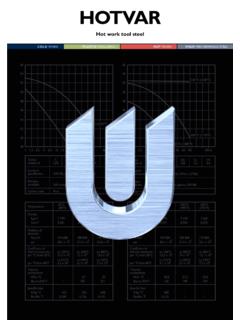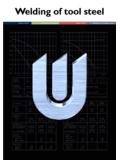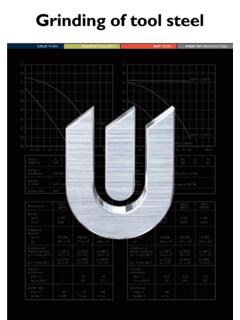Transcription of CALMAX - Bohler Uddeholm
1 CALMAXP lastic mould and cold work steelCALMAX2 PropertiesPHYSICAL DATAT emperature20 C200 C400 C(68 F)(400 F)(750 F)Densitykg/m37 7707 7207 650lbs/in30,2810,2790,276 Modulus ofelasticityN/mm2194 000188 000178 000psi28,1 x 10627,3 x 10625,8 x 106 Coefficient ofthermal expansionto 100 Cto 200 Cto 400 Cper C from 20 C11,7 x 10-612,0 x 10-613,0 x 10-6to 212 Fto 400 Fto 750 Cper F from 68 F 6,5 x 10-6 6,7 x 10-6 7,3 x 10-6 ThermalconductivityW/m C 27 32 Btu in (ft2h F) 187221 Specific heatJ/kg C455525608 Btu/lbs F0,1090,1260,145 Cover photos:Cold work and plastic products where CALMAX would be a good choice for the is a steel suitable for both cold workand plastic applications. For further information seepage 6 and is a chromium-molybdenum-vanadiumalloyed steel characterized by: High toughness Good wear resistance Good through hardening properties Good dimensional stability in hardening Good polishability Good weldability Good flame- and induction blanking die where CALMAX could be used becauseof the high demands on for the production of electrical components.
2 CALMAX would be a good choice here because of the high demandson wear STRENGTHA pproximate values at room ,2 HRCN/mm2N/mm2562300190058250020006027002 100 IMPACT STRENGTHA pproximate values at room temperature fordifferent tempering temperatures. Hardened at960 C (1760 F). Quenched in air. Tempered VImpact energy, KV, (J)605040302010 0 200 250 300 350 400 450 500 550 600 C 390 480 570 660 750 842 930 1020 1110 F Tempering temperatureKV6050403020100 KICT ypicalCSiMnCrMo Vanalysis %0,60,350,84,50,5 0,2 DeliveryconditionSoft annealed to approx. 200 HBColour codeWhite/violetFracture toughnessKIC,(MPa m)CALMAX3 900 925 950 975 1000 C 1650 1695 1740 1785 1830 FHardness and retained austenite as a function ofaustenitizing temperatureHeat treatmentSOFT ANNEALINGP rotect the steel and heat through to 860 C(1580 F), holding time 2h.
3 Cool in furnace 20 C/h to770 C (35 F/h to 1420 F), then 10 C/h to 650 C(18 F/h to 1200 F) and subsequently freely in RELIEVINGA fter rough machining the tool should be heatedthrough to 650 C (1200 F), holding time slowly to 500 C (930 F), then freely in : 600 750 C (1110 1380 F).Austenitizing temperature: 950 970 C (1740 1780 F), normally 960 C (1760 F).HardnessTemperatureHolding* time before tempering C Fminutes (HRC)950174030629601760306397017803064* Holding time = time at austenitizing temperature afterthe tool is fully heated HRC656463626160595857 Austenitizing temperature123123123 Risk for grain growth causing reduced the part against decarburization andoxidation during MEDIA Forced air/gas Vacuum furnace with sufficient overpressure Martempering bath or fluidized bed at200 550 C (320 1020 F) followed by forcedair cooling 1: Quenching in oil gives an increased risk fordimensional changes and 2: Temper the tool as soon as its temperaturereaches 50 70 C (120 160 F).
4 CCT-graphAustenitizing temperature 960 C. Holding time 30 temperature 960 CHolding time 30 minutes1101001 00010 000100 000 Seconds1101001 000 Minutes110100 Hours11001000900800700600500400300200100 C200018001600140012001000800600400200 F3 AcA1cCarbidesMartensitePearliteBainite13 45672 Cooling Hard-CurvenessT800 austenite %201510 5 CALMAX4 SURFACE TREATMENTSome tools are given a surface treatment in order toreduce friction and increase tool wear most commonly used treatments are nitridingand surface coating with wear resistant layers oftitanium carbide and titanium nitride (CVD, PVD).Two commonly used nitriding processes are ionnitriding and gas nitriding. Ion nitriding is normallyperformed at a lower temperature than gas nitridingand is, therefore, the preferred method for CALMAX when a substrate hardness of 54 HRC is the tempering temperature according to thehardness required by reference to the temperinggraph. Temper twice with intermediate cooling toroom temperature.
5 Lowest tempering temperature180 C (360 F). Holding time at temperatureminimum 2h. 100 200 300 400 500 600 C 210 390 570 750 930 1110 F Tempering temperature (2h + 2h)Tempering graphHardness HRCR etained austenite %15105656055504540353025 DIMENSIONAL CHANGESThe dimensional changes during hardening andtempering vary depending on temperature, type ofequipment and cooling media used during size and geometric shape of the tool are also ofessential importance. Thus the tool should alwaysbe manufactured with enough working allowanceto compensate for distortion. Use 0,20% as aguideline for example of dimensional changes for a plate100 x 100 x 10 mm, hardened and temperedunder ideal conditions, is shown in the temperature960 C (1760 F)Retained austeniteA thick case depth considerably reduces the tough-ness of the tool. The case depth, which can becontrolled by the nitriding time, should be selectedto suit the application in can also be CVD coated but the depositiontemperature should not exceed 960 C (1760 F).
6 Thetool should be re-hardened after being coatings can be deposited at temperaturesbetween 200 C (390 F) and 500 C (930 F). If200 C (390 F) is used, the CALMAX substratehardness will be higher than that obtained at adeposition temperature of 500 C (930 F). However,the adhesion of the coating on the steel is better ifa deposition temperature of 500 C (930 F) is PVD deposition temperature should be C (68 F) lower than the previously used temper-ing CTimeCase depthhardnesshardnessprocess ( F)(h)mmHRCHVIon465*18200541075(870*)Gas5 10*12200521075(950*)0,100,080,060,040,02 0 0,02 0,04%100 200 300 400 500 C210 390 570 750 930 FTempering temperature (2h + 2h) ..WidthLengthThicknessHardening: 960 C (1760 F)/30 * The nitriding temperature used should be 15 25 C (59 77 F)lower than the previously used tempering dataRough millingFine millingparameterscarbidecarbideCutting speed (vC) m/min160 240240 280 787722 919 Feed (fZ) mm/tooth0,2 0,40,1 0,2 in/tooth0,008 0,0160,004 0,008 Depth of cut (aP)mm2 5 2inch0,08 0,200,08 Carbidedesignation ISOP20 P40P10 P20 USC6 C5C6 C7 Coated carbideCoated carbideor cermetCarbide drillType of drillCutting dataSolidIndexableBrazedparameterscarbid einsertcarbide1)Cutting speed(vC) m/min120 150210 23070 100 492689 755230 328 Feed (f)mm/r 0,10 0,352)0,03 0,122) 0,15 0,402) ,004 0,0142)0,001 0,0052) 0,006 0,0162)1)Drills with internal cooling channels and a brazed )Depending on drill diameter.
7 Type of end millCarbideCutting dataSolidindexableHigh speedparameterscarbideinsertsteelCutting speed (vC)m/min120 150150 200 40 451) 492492 656131 1481)Feed (fZ)mm/tooth0,006 0,202)0,06 0,202)0,01 0,352)in/tooth0,0002 0,0082)0,002 0,0082)0,0004 0,0142)CarbidedesignationISO P15 P40 US C6 C5 1) For coated HSS end mill vC =55 60 m/min. (180 197 ).2) Depending on radial depth of cut and cutter millingMachiningrecommendationsThe cutting data below are to be considered asguiding values which must be adapted to existinglocal : Soft annealed to approx. 200 HBTURNINGGRINDINGA general grinding wheel recommendation is givenbelow. More information can be found in theUddeholm brochure Grinding of Tool Steel .Wheel grindingSoft annealedHardenedType of grindingconditionconditionFace grinding straight wheelA 46 HVA 46 HVFace grinding segmentsA 24 GVA 36 GVCylindrical grindingA 46 LVA 60 KVInternal grindingA 46 JVA 60 JVProfile grindingA 100 LVA 120 JVRoughFineFine turningCutting dataturningturningHigh speedparameterscarbidecarbidesteelCuttin g speed(vC)m/min150 200200 25020 656656 82066 82 Feed (f)mm/r0,2 0,40,05 0,20,05 0, ,008 0,0160,002 0,0080,002 0,01 Depth of cut (aP)mm2 40,5 20,5 3inch0,08 0,160,02 0,080,02 0,12 Carbidedesignation ISOP20 P30P10 USC6 C5C7_CoatedCoated carbidecarbideor cermetMILLINGFace and side millingDrill diameterCutting speed (vc)Feed (f)mminch 513 15*43 49*0,05 0,100,002 0,004 5 1013 15*43 49*0,10 0,200,004 0,00810 1513 15*43 49*0,20 0,250,008 0,01015 2013 15*43 49*0,25 0,300,010 0,012* For coated HSS drill vc =23 25 m/min.
8 (75 82 ).DRILLINGHigh speed steel twist drill 3/163/16 3/8 3/8 5/8 5/8 3/4 CALMAX6 Cold work applicationsTYPICAL APPLICATION AREAS General blanking and forming Heavy duty blanking and forming Deep drawing Coining Cold extrusion dies with complicated geometry Rolls Shear blades Prototype PRESSWORK STEELSThe majority of presswork tools used today aremanufactured using traditional tool steels such asO1, A2, D2, D3 or steels offer an apparent adequate wearresistance and their hardness range is suitable formost applications. However, the poor toughness,flame- and induction hardenability and weldabilityof these grades often results in low productivity andhigh maintenance costs due to unexpected toolfailure. For this reason, the new general pressworktool steel CALMAX has been developed. The aim ofCALMAX is to secure an optimal tooling economy, the lowest tooling costs per part DEMANDSThe pressworking industry has gone through someconsiderable changes in the last decades.
9 Stainlesssteel and surface coated strip have been commer-cialized and high speed presses have been devel-oped. To these technological advances just in time(JIT) manufacture and the moves toward increasedproductivity and tool life guarantees must be traditional presswork tool steels are stillroutinely specified and selected but often result inpoor tool performance and well balanced properties profile of CALMAX ismuch better matched to modern work materials andmanufacturing methods. CALMAX offers the highdegree of safety which is essential for optimaltooling performance and maximum TO FAILURE MECHANISMSW eldingGood results when welding CALMAX can beachieved if proper precautions are keep the arc length as short as electrode should be angled at 90 to thejoint sides to minimize under cut. In addition,the electrode should be held at an angle of 75 80 to the direction of forward large repairs, weld the initial layers with asoft weld metal.
10 Make the two first layers withthe same electrode diameter and Large repair welds should be made at joints should be prepared TREATMENT AFTER WELDINGH ardened conditionTemper at 10 20 C (50 70 F) below the originaltempering annealed conditionHeat through to 860 C (1580 F) in protectedatmosphere. Cool in furnace at 10 C/h to 650 C(18 F/h to 1200 F), then freely in information on welding of tool steel is givenin the Uddeholm brochure Welding of Tool Steel .CALMAXARNESVERKER 21 SVERKER 3 RIGORSLEIPNERAbra-Adhe- UddeholmsivesiveGrossDefor- gradewearwearChippingCrackingmationTIG Welding recommendationsHardnessHardness afterPreheatConsumablesas weldedrehardeningtemperUTPA 73G253 56 HRC51 HRCUTPA 67S55 58 HRC52 HRCC astoTig 5*60 64 HRC 200 250 CCALMAX/CARMO (390 480 F)TIG WELD58 61 HRC58 61 HRC*CastoTig 5 should not be used for more than 4 layers because of theincreased risk of (SMAW) Welding recommendationsHardnessHardness afterPreheatConsumablesas weldedrehardeningtemperESAB OK 54 HRC 49 HRCUTP 67S55 58 HRC 52 HRCCITODUR 600B57 60 HRC53 54 HRCF ontargen E 71157 60 HRC53 54 HRCCALMAX/CARMOWELD58 61 HRC58 61 HRC200 250 C(390 480 F)EDMIf spark erosion is performed in the hardened andtempered condition, the tool should be given anadditional temper at about 25 C (35 F)







